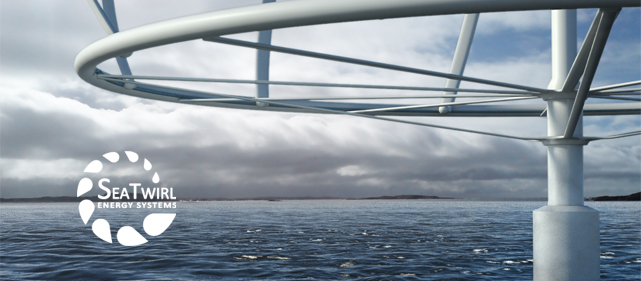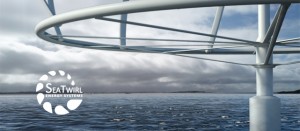
SeaTwirl has created a vertical axis wind turbine (VAWT) that is both direct-drive and stores energy using seawater. It also uses water as a bearing, which has the advantage of low friction.
The generator is of the permanent magnet type. This means that it partially utilizes magnets (magnetic materials such as neodymium) to turn the rotor. The other type of generator (induction) utilizes electromagnets (coils of copper wire) completely.
When the wind speed decreases, the seawater that was drawn into the structure through the shaft and into the torus by centrifugal force is used to maintain turning momentum, acting as a flywheel. The turbine actually collapses its blades to reduce drag so it can spin as a flywheel and then generate as much electricity as possible.
Traditional power-generating flywheels are often, literally, heavy wheels that are spun by an electric motor (which could be powered by wind turbines) up to a certain speed.
When the wind speed has slowed down so much that the wind turbines don’t generate enough electricity, the flywheel’s heavy weight causes it to keep spinning for a very long time (this is caused by inertia) and it turns a generator which could either be the same motor that turned it, or a separate generator.
A flywheel is “charged” by powering the electric motor that spins it, and it is “discharged” by drawing current from the generator that the flywheel itself is spinning.
“The concept is very simple, with effectively only one moving part,” says chief executive Daniel Ehrnberg. “There is no need for a conventional transmission based around a Cardan [drive] shaft, gearbox or roller bearing.” The latter, he adds, is not needed to take the weight of the turbine, “as the water does this”.
A model of the concept, which was partially inspired by spinning wooden tops used in traditional games, was initially tank-tested at Gothenburg University, Sweden in 2007.
Then a prototype that was four meters tall was built and moored (fastened to the floor) in a lake in Småland, Sweden, to prove the water-as-roller-bearing concept.
“Scaling up this concept 100 or 1,000 times will make the ratio between energy-storage capacity and surface area affected by friction increase by 1,000,” notes Ehrnberg. “This means that large-scale models could spin for much longer and hold much more energy.
Ehrnberg is optimistic that this turbine can be scaled up to 10 MW, which he said would be “an economic, efficient industrial size”.
(Source)

 Follow
Follow